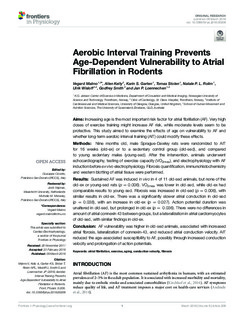| dc.description.abstract | Aims: Increasing age is the most important risk factor for atrial fibrillation (AF). Very high doses of exercise training might increase AF risk, while moderate levels seem to be protective. This study aimed to examine the effects of age on vulnerability to AF and whether long-term aerobic interval training (AIT) could modify these effects.
Methods: Nine months old, male Sprague-Dawley rats were randomized to AIT for 16 weeks (old-ex) or to a sedentary control group (old-sed), and compared to young sedentary males (young-sed). After the intervention, animals underwent echocardiography, testing of exercise capacity (VO2max), and electrophysiology with AF induction before ex vivo electrophysiology. Fibrosis quantification, immunohistochemistry and western blotting of atrial tissue were performed.
Results: Sustained AF was induced in vivo in 4 of 11 old-sed animals, but none of the old-ex or young-sed rats (p = 0.006). VO2max was lower in old-sed, while old-ex had comparable results to young-sed. Fibrosis was increased in old-sed (p = 0.006), with similar results in old-ex. There was a significantly slower atrial conduction in old-sed (p = 0.038), with an increase in old-ex (p = 0.027). Action potential duration was unaltered in old-sed, but prolonged in old-ex (p = 0.036). There were no differences in amount of atrial connexin 43 between groups, but a lateralization in atrial cardiomyocytes of old-sed, with similar findings in old-ex.
Conclusion: AF vulnerability was higher in old-sed animals, associated with increased atrial fibrosis, lateralization of connexin-43, and reduced atrial conduction velocity. AIT reduced the age-associated susceptibility to AF, possibly through increased conduction velocity and prolongation of action potentials. | nb_NO |

